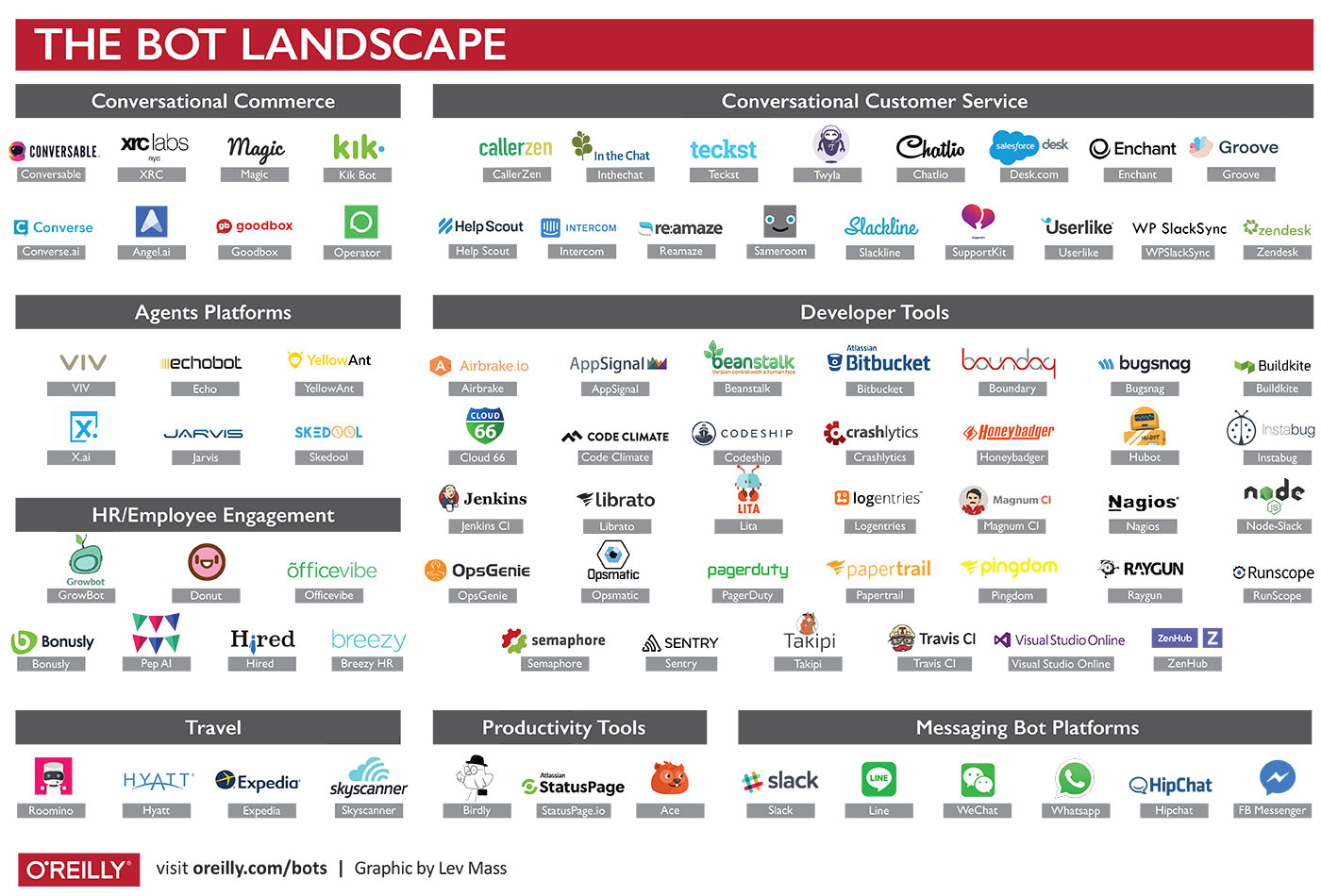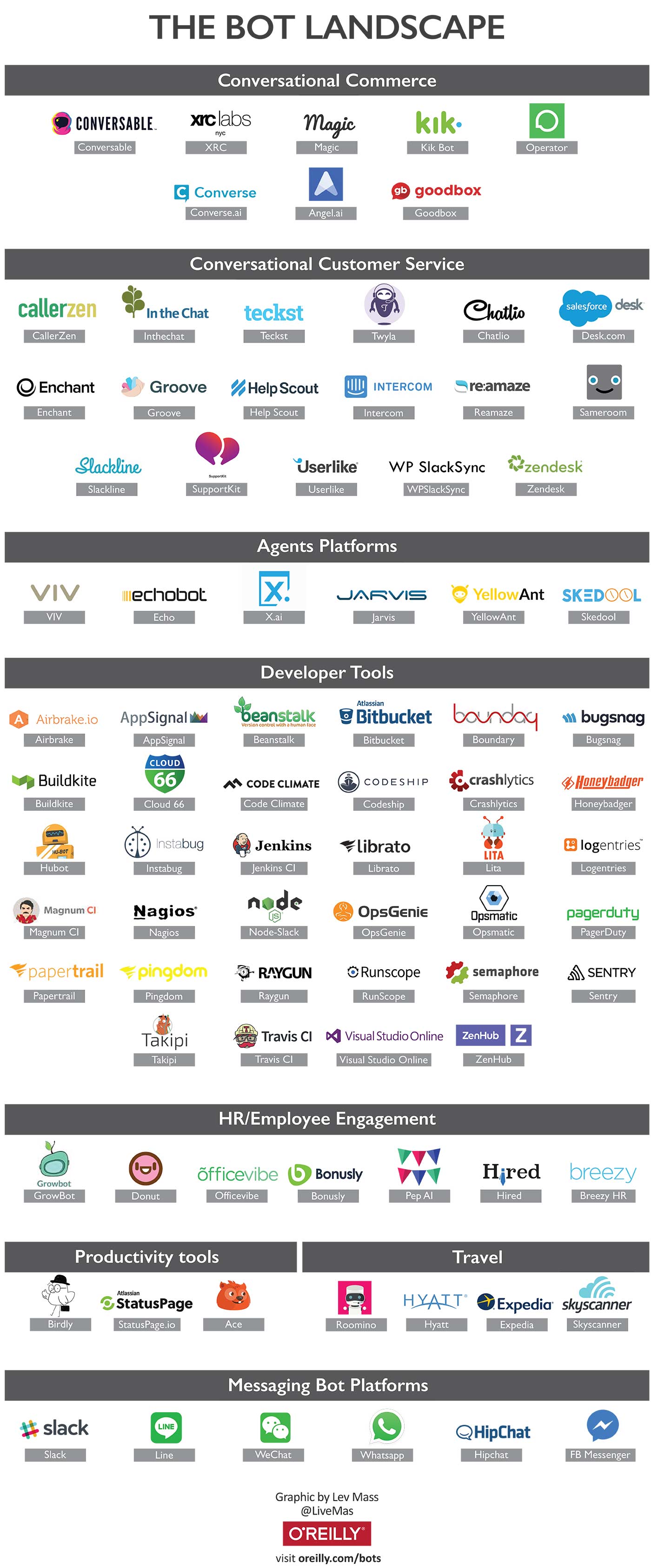An overview of the bot landscape
Are bots your new best friend?
 Bots landscape. (source: Lev Mass)
Bots landscape. (source: Lev Mass)
Bots are a growing segment of software that acts as an agent on a human’s behalf. These tasks range from ordering online, to making dinner reservations, to handling customer service requests, to helping employees be more productive in the workplace.
Historically, most bots have used simple rules-based approaches to present an output for a given input (such as presenting the weather). But today, with advances in server-side processing power and improvements in implementing artificial intelligence (AI) and machine learning (ML), bots are starting to provide real value to consumers. The tide has finally turned and bots are entering the mainstream consciousness, especially after the recent announcements at Facebook’s annual conference F8.
This is the year of the bot, with many companies looking to automate boring, repetitive, or manual tasks. Imagine not having to dial a 1-800 number but instead texting your wishes to your airline (or better yet the airline anticipating your needs and texting you). This kind of service can be powered by bots, and we’re sure to see more applications in the near future. Just about every venture firm and corporation is trying to wrap their heads around where they can leverage bots and how to plan a bot strategy.
Evolution
The idea behind bots dates back to Alan Turing’s early research on computing machinery and intelligence in the 1950s. Turing laid out the idea behind what is now known as the Turing test, whereby a human and a computer would interact entirely by written messages. Turing posited that if the human recipient couldn’t tell the human and the computer apart, then the computer should be labeled as intelligent.
The first wave of bots were based on rules programmed into the software and were used to automate simple, repetitive tasks. However, bots have advanced to the point where they are streamlining support cases, explaining frequently asked questions, scheduling appointments, and completing orders. Originally, these tasks required multiple inputs from a human to answer rule-based logic questions. But with advancements in AI and leveraging deep learning, bots are now able to perform more complex tasks and write their own commands on the fly using massive data sets to answer even more complex queries.
Transactional bots
The potential uses for bots are tremendous given the breadth of potential applications. Over the past few years, most bots just delivered information to the user in a question/answer format and were not truly conversational. A user interacted with the bot, and it pulled data from its own database and surfaced it to the user. An example of this kind of bot is the North Face bot, which helps customers find the right jacket based on inputs that are specific to their plans—in other words, location, climate, projected activities, and so forth.
However, the real value of bots is in their agency to act on your behalf. Bots with agency can help consumers save time by interacting with services on their behalf. A perfect example would be a Slackbot that files tickets for a software development team or completes a customer service request. Because there are so many possible uses, especially for businesses, expect to see a massive increase in these kinds of transactional bots that pass data back and forth between separate platforms.
A move toward the consumer
Currently, most of the focus on bots is on messaging apps. Users’ time spent in messaging apps has recently surpassed time spent in social networks. More than 2.5 billion people have at least one messaging app on their phones.
This new medium of interacting with intelligent computers has spawned the term “chatbot.” Slack and Facebook (and others) are working to create a whole new ecosystem based on this premise as a more efficient medium of communication and productivity.
The market for bot applications is huge and will parallel the pool of users already using chat as a channel to interact with friends and family. Why not use it to complete tasks in your daily life? When you have a channel that gives you access to more than a billion people, developers start to take notice.
The future of bots
Most business models for chatbots are still emerging, but as we look to Asia—where WeChat has hundreds of millions of users—we find applications that let you transact within WeChat. Even though it is still early for ecommerce in chat applications, we are seeing interesting use cases, such as selling children’s books and apparel. In these use cases the brand is making a personal appeal to their consumers in chat. In the modern economy, we are all presented with the paradox of choice; bots are a great application to help surface actionable insights or refine our options and take action.
Amazon is leveraging this power with Echo, to help people seamlessly interact with commerce and their world. In doing so, it also nicely helps people transact on Amazon. By removing the need to look at prices when you order by voice, Echo abstracts the desire for the product from the cost, even as—in some cases—the cost is slightly elevated to compensate for the ease of ordering.The more seamless integration of voice ordering also increases velocity of commerce done through the Echo. As with all services, there is no free lunch.
Imagine using the agency power of chatbots to save your most precious resource: time.
Because time is money, people will pay to automate many tedious aspects of their lives, and thus the potential for customer-facing businesses to provide new services and means of services is very promising. Saving the consumer time is just one of the compelling use cases of bots.
The future is not just one of building standalone bots or bots on platforms. The big question is: What will the inflection point be with bots? When the Apple App Store launched, it catapulted apps to the mainstream—now we can’t imagine a smartphone without apps. It remains to be be seen what the dominant distribution mechanism will be for bots. This is quite literally a billion dollar question.
The first step in building the future of bots is understanding the landscape today. The below is one way to visualize the developing landscape.

